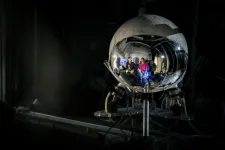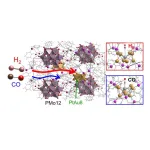(Press-News.org) Why do our mental images stay sharp even when we are moving fast? A team of neuroscientists led by Professor Maximilian Jösch at the Institute of Science and Technology Austria (ISTA) has identified a mechanism that corrects visual distortions caused by movement in animals. The study, conducted in mice, identifies a core function that can be generalized across the vertebrate visual system, including primates such as humans. The findings are published in Nature Neuroscience.
Despite its rapid development in recent decades, the video camera industry is still catching up with the capabilities of the human eye. In particular, action cams are designed to capture footage while immersed in the action. As we judge footage quality and the need for fancy equipment and optimization software based on the abilities of the human eye, a question arises: How do our eyes do it so well?
Researchers led by Professor Maximilian Jösch at the Institute of Science and Technology Austria (ISTA) have now answered this question with a technical tour de force. The three scientists and co-first authors Tomas Vega-Zuniga, Anton Sumser, and Olga Symonova combined a range of state-of-the-art techniques to identify a brain region in the mouse that can predict and minimize how movements distort the visual signal. This brain region, residing deep in the brain, literally copies the brain’s motor commands to suppress movement-induced distortions. “We show that the image correction happens very early during visual processing—before the information is transmitted to other areas of the brain that are known to represent more complex visual features,” says Jösch. “Thus, we demonstrate that the mammalian brain devises strategies to compensate for movement efficiently by predicting its effects on vision.”
Formula 1 footage without postproduction
The scientists pinpointed the “ventral lateral geniculate nucleus” (vLGN) as the brain region responsible for this built-in high-tech video optimization software. It is located in the lateral thalamus, an egg-shaped structure in the center of the brain, below the cerebral cortex. The researchers found that the vLGN integrates various motor and sensory signals from throughout the brain, and acts as a hub to compute a comprehensive corrective signal. One example is the ‘unblurring’ of visual signals as soon as the eye moves. This allows later stages of visual processing to be computed much more efficiently. “Think about strategies to get good video footage during a Formula 1 race. Because the cars are moving so fast, the exposure time has to be reduced to make the final footage less blurry,” explains Jösch. Such footage can be broadcast live on television without any post-production. This is roughly what the vLGN does to help us distinguish our own motion from that of the world around us. However, unlike a stationary camera showing the cars racing by, the brain's vLGN processes signals similarly to the Formula 1 ‘driver’s eye’ onboard footage, dynamically compensating for the motion to stabilize what we perceive.
A core function that flew under the radar
Previous work has searched for a mechanism that effectively adjusts vision during motion. Much of this work has focused on studying saccadic eye movements in primates. Saccades are rapid shifts of the center of gaze from one part of the visual field to another, a movement that should theoretically blur or create a mental image—but does not always do so. However, these studies focused on cortical structures that are involved in much later stages of the visual processing pathway. As opposed to this, our sensory system is constantly ‘bombarded’ by various types of movements. So, the earlier the brain can compensate for movement in vision, the better, explains Jösch. “Our findings were likely not observed until now because we had been looking at stages in the visual processing pathway where the image had already been corrected.” Now, the ISTA scientists hypothesize that their findings on the vLGN in mice represent a core function in the mammalian brain. “Similar structures exist in primates, and this is very likely the case for humans, too. This makes our results very exciting,” says Jösch.
A virtual reality system to image the brain in vivo
Among the cutting-edge technologies the ISTA scientists used was a custom-built two-photon calcium imaging microscope. This technique allows the team to measure vLGN neuronal activity in the intact brain while the mice are awake and are behaving normally in a virtual reality system. “With this setup, we can look into the brain of a mouse and observe the activity of the vLGN nerves while the mice are wandering through a virtual world,” says Jösch. Using this method, the team discovered that the vLGN receives very specific copies of behavioral instructions that can be used to ‘unblur’ visual distortions during movement. “This paper was a real technical tour de force, using multiple approaches to gain a comprehensive understanding of the role of the vLGN in the mouse brain,” says Jösch. “We are excited to see where the follow-up studies will take us.”
-
Information on animal studies
To better understand fundamental processes, for example, in the fields of neuroscience, immunology, or genetics, the use of animals in research is indispensable. No other methods, such as in silico models, can serve as an alternative. The animals are raised, kept, and treated according to strict regulations.
END
High-tech video optimization in our brain
ISTA scientists uncover how the brain unblurs vision during movement
2025-02-10
ELSE PRESS RELEASES FROM THIS DATE:
Euclid discovers a stunning Einstein ring
2025-02-10
Euclid blasted off on its six-year mission to explore the dark Universe on 1 July 2023. Before the spacecraft could begin its survey, the team of scientists and engineers on Earth had to make sure everything was working properly. During this early testing phase, in September 2023, Euclid sent some images back to Earth. They were deliberately out of focus, but in one fuzzy image Euclid Archive Scientist Bruno Altieri saw a hint of a very special phenomenon and decided to take a closer look.
“I look at the data from Euclid as it comes in,” explains Bruno. “Even from that first observation, I could see it, but after Euclid made more observations of the area, ...
Biotech in Germany has significant potential, but lack of collaboration hampers growth
2025-02-10
The report “Assessing Deep-Tech Innovation Hubs in Germany: The Case of Biotechnology” evaluates Germany’s performance in deep-tech innovation within biotech using a comprehensive index and examines five key hubs: Berlin, Heidelberg, Munich, Nuremberg-Erlangen, and Stuttgart. These hubs were analyzed in terms of fundamental research, research and development in biotech, startup activity, public infrastructure, and business environment.
Berlin, Munich, and Heidelberg are the leading biotech hubs
Berlin leads the index due to its strong public infrastructure ...
Does pain affect cancer survivors’ use of non-opioid substances?
2025-02-10
Experiencing pain may increase the odds that cancer survivors will use cigarettes and cannabis, according to a recent study published by Wiley online in CANCER, a peer-reviewed journal of the American Cancer Society. The study also found that cigarette smoking and pain are linked to more treatment-related side effects and worse health among cancer survivors.
Pain and use of cigarettes, e-cigarettes, alcohol, and cannabis commonly occur together in the general population. To characterize pain in relation to such non-opioid substance ...
Scientists find that a playful approach to life activates ‘lemonading’, which helps people cope with adversity
2025-02-10
Scientists have found that taking a playful approach to life doesn’t mean you don’t take your situation seriously, but it can mean you cope with it better. By surveying people about their experiences during a Covid-19 lockdown, they learned that more playful people were more positive about the future and coped more actively and creatively. Life gave them lemons, and they made lemonade.
“Our study revealed that playfulness and resilience are intimately connected through what we call ‘lemonading’ — the ability to imagine ...
Candidate genes in canine hepatocellular carcinoma for molecular targeted therapy
2025-02-10
Unresectable canine hepatocellular carcinoma (HCC) has limited nonsurgical treatment options. Sorafenib is a targeted therapy for unresectable canine HCC. However, there are limited reports on the expression of target genes. Therefore, the efficacy of the targeted therapies for canine HCC remains unclear.
In HCC, the prognosis is generally good when complete surgical resection is possible. Unresectable nodular and diffuse HCC have a poor prognosis and limited nonsurgical treatment options. In humans, systemic therapies including ...
Opioid prescriptions in the ED linked to small increases in future opioid use, hospitalizations
2025-02-10
Opioid prescriptions in the emergency department (ED) were associated with small increases in later opioid prescriptions and hospital admissions, found new research published in CMAJ (Canadian Medical Association Journal) https://www.cmaj.ca/lookup/doi/10.1503/cmaj.241542.
To understand the relationship between opioid prescribing in the ED and subsequent harm, researchers looked at opioid prescribing at all Alberta EDs from 2010 to 2020. Of the more than 13 million visits, 689 074 patients (5.3%) filled an opioid prescription. The researchers found that opioid prescriptions did not increase the risk of ...
During pandemic, playful people were remarkably resilient, OSU research shows
2025-02-10
CORVALLIS, Ore. – Adults with high levels of playfulness showed strong resilience during the COVID-19 pandemic compared to less playful individuals, new research shows.
The study led by Xiangyou “Sharon” Shen of Oregon State University is important because playfulness is a vital but underappreciated resource for building resilience and maintaining well-being during difficult periods such as the pandemic, Shen said. And it’s a resource that individuals can cultivate.
“Understanding how playful people navigate adversity can inform interventions and strategies to help people cope with stress and uncertainty,” said Shen, an assistant professor ...
Tracing gas adsorption on “crowns” of platinum and gold connected by nanotunnels
2025-02-08
Tokyo, Japan – Researchers from Tokyo Metropolitan University have elucidated how hydrogen and carbon monoxide is adsorbed into solids containing a crown-motif structure of platinum and gold. Using quick-scan X-ray absorption measurements and theoretical calculations, they studied a solid of [PtAu8(PPh3)8]-H[PMo12O40] called PtAu8-PMo12 and found that gas adsorption is affected strongly by the dimension of nanoscale voids in the structure. This highlights the importance of engineering voids in materials for next generation sensors and gas separation.
Ligand-protected metal clusters have been a source of ...
Rare bird skull from the age of dinosaurs helps illuminate avian evolution
2025-02-08
A new study in Nature describing a fossil of a nearly complete and intact bird skull from Antarctica is shedding light on the early evolution of today’s birds and avian diversity at the end of the Age of Dinosaurs.
The skull is from Vegavis iaai, an extinct duck-like bird that lived during the Late Cretaceous, just before non-avian dinosaurs went extinct. It’s one of very few 3D bird skulls known to science from the Cretaceous — a 79-million-year geological period and the last era when ...
Researchers find high levels of the industrial chemical BTMPS in fentanyl
2025-02-08
A UCLA research team has found that drugs being sold as fentanyl contain high amounts of the industrial chemical bis(2,2,6,6-tetramethyl-4-piperidyl) sebacate, or BTMPS. This new substance of concern emerged in the illicit drug supply nearly simultaneously in multiple U.S. locations from coast-to-coast.
From June through October 2024, the team quantitatively tested samples of drugs sold as fentanyl that had high levels of the chemical, which belongs to a class of compounds called hindered amine light stabilizers ...
LAST 30 PRESS RELEASES:
Heart-brain connection: international study reveals the role of the vagus nerve in keeping the heart young
Researchers identify Rb1 as a predictive biomarker for a new therapeutic strategy in some breast cancers
Survey reveals ethical gaps slowing AI adoption in pediatric surgery
Stimulant ADHD medications work differently than thought
AI overestimates how smart people are, according to HSE economists
HSE researchers create genome-wide map of quadruplexes
Scientists boost cell "powerhouses" to burn more calories
Automatic label checking: The missing step in making reliable medical AI
Low daily alcohol intake linked to 50% heightened mouth cancer risk in India
American Meteorological Society announces Rick Spinrad as 2026 President-Elect
Biomass-based carbon capture spotlighted in newly released global climate webinar recording
Illuminating invisible nano pollutants: advanced bioimaging tracks the full journey of emerging nanoscale contaminants in living systems
How does age affect recovery from spinal cord injury?
Novel AI tool offers prognosis for patients with head and neck cancer
Fathers’ microplastic exposure tied to their children’s metabolic problems
Research validates laboratory model for studying high-grade serous ovarian cancer
SIR 2026 delivers transformative breakthroughs in minimally invasive medicine to improve patient care
Stem Cell Reports most downloaded papers of 2025 highlight the breadth and impact of stem cell research
Oxford-led study estimates NHS spends around 3% of its primary and secondary care budget on the health impacts of heat and cold in England
A researcher’s long quest leads to a smart composite breakthrough
Urban wild bees act as “microbial sensors” of city health.
New study finds where you live affects recovery after a hip fracture
Forecasting the impact of fully automated vehicle adoption on US road traffic injuries
Alcohol-related hospitalizations from 2016 to 2022
Semaglutide and hospitalizations in patients with obesity and established cardiovascular disease
Researchers ‘listen in’ to embryo-mother interactions during implantation using a culture system replicating the womb lining
How changing your diet could help save the world
How to make AI truly scalable and reliable for real-time traffic assignment?
Beyond fragmented markets: A new framework for efficient and stable ride-pooling
Can shape priors make road perception more reliable for autonomous driving?
[Press-News.org] High-tech video optimization in our brainISTA scientists uncover how the brain unblurs vision during movement






